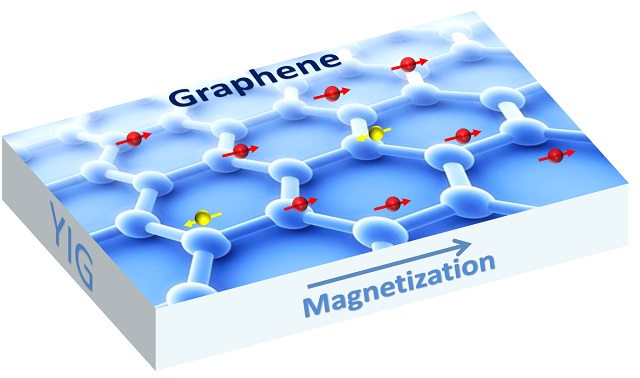 Graphene is a one-atom thick sheet of carbon atoms arranged in a hexagonal lattice. UC Riverside physicists have found a way to induce magnetism in graphene while also preserving graphene’s electronic properties. (Image Credit: Shi Lab, UC Riverside)
Graphene is a one-atom thick sheet of carbon atoms arranged in a hexagonal lattice. UC Riverside physicists have found a way to induce magnetism in graphene while also preserving graphene’s electronic properties. (Image Credit: Shi Lab, UC Riverside)
A research team from the University of California, Riverside has developed a new technique of inducing magnetism in graphene without disrupting graphene’s electronic properties. Graphene is a single layer of carbon atoms in a hexagonal lattice, and has many amazing properties. The magnetic properties of graphene have remained controversial due to the lack of strong experimental evidence. In general, upon doping graphene with magnetic impurities, magnetism can be induced in graphene. However, the doping may affect the electronic properties of the material.
The study, published in Physical Review Letters, involves bringing a graphene sheet very close to a magnetic insulator, which is an electrical insulator having magnetic properties. The findings prove that the magnetism-induced graphene has potential applications in computer chips that employ electronic spin to store data.
This is the first time that graphene has been made magnetic this way. The magnetic graphene acquires new electronic properties so that new quantum phenomena can arise. These properties can lead to new electronic devices that are more robust and multi-functional.
Jing Shi, a lead author of the research and a professor of physics and astronomy
The research team used yttrium iron garnet developed by laser molecular beam epitaxy in Shi's lab, as the magnetic insulator. Upon placing a single-layer graphene sheet on a smooth yttrium iron garnet layer, the researchers observed that the graphene sheet was magnetized by yttrium iron garnet i.e. the magnetic properties of yttrium iron garnet were transferred to the graphene.
Iron particles with magnetic properties may also interfere with graphene’s electrical conductivity. Hence the researchers avoided that substance, and opted yttrium iron garnet that does not affect graphene's electrical transport mechanism. They found that the remarkable electrical transport properties of graphene remained stable by just placing it over the layer of yttrium iron garnet.
During their experiments, the researchers applied external magnetic field to the graphene. They observed that the graphene’s Hall voltage which is perpendicular to the flow of current is linearly dependant on the magnetization of yttrium iron garnet. This enabled them to confirm the magnetic properties of the graphene sheet.
The co-authors of the study include Yafis Barlas, Raymond Sachs, Chi Tang and Zhiyong Wang who is also the first author of the paper. The research work was supported by the U.S. Department of Energy and the National Science Foundation.
References